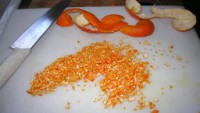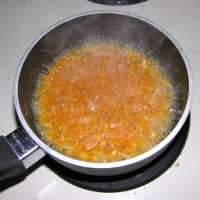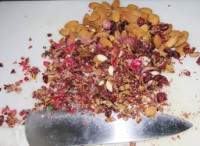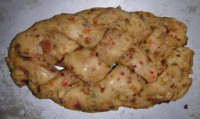In fact, stollen is traditionally rolled out oval, then folded over into a crescent. I seem to recall reading somewhere about some symbolism relating to Christ, with the nuts folded inside, or something, or maybe it was some other, totally different christmas related sweet bread.
At any rate, since I'm agnostic, I'm not especially worried about Christian symbolism, and I doubt my mother (who is Catholic, albeit technically a heretic) did either. What she liked about the recipe was the fact that it directed the candied fruit be chopped very fine—she felt the big chunks called for in other previous stollen recipes she encounted less than appealing. Think fruitcake, with its big wodgy chunks of sugary chewy gummy-bear (ugh!) consistancy fruit, and you'll know what I mean. (In fact, I bet fruitcake could be made 100% more appealing by cutting the fruit in that smaller, too.) Since chopping stuff up fine is my favorite thing to do in the kitchen, to the point that I actually have to discipline myself to chop coarsely, this recipe is a natural for me.

Drizzled (in curliQ patterns, of course) and ready to eat. Slice and serve with more icing, or butter, or just out of hand.
But braiding, on the other hand—how could I resist? However, the shape of the bread is only the most obvious change I made to the recipe, for which reason I bought my very own copy of The Settlement Cookbook—though it has quite fascinating hints on the world of our immigrant foremothers: did you know you could clean the dust bunnies under the bed with damp tea leaves? Or that your garbage can needs to be scrubbed out once a week? Hurray for trash liners, however ecologically incorrect they may be...(This cookbook originally collated the recipes of turn-of-the-20th-ca German and other European immigrants, along with instructions for healthy and hygienic living in the new country and even my updated version still has a lot of these tidbits).
Okay. Onto the recipe. You will need:
Stollen (German Holiday Bread)
- 1 pkg instant dry yeast (or 1-1/2 T bulk granules)
- 1/2# (2 sticks) butter
- 1 C milk
- 1/2 t salt
- 1/2 C white granulated sugar
- 2 eggs
- 4-1/4 C unbleached all-purpose flour (plus additional, up 2 C) for kneading
- 1/2 C candied orange peel (recipe follows)
- 1/2 C candied citron, finely chopped
- 7/8 C finely chopped almonds
- 1 C finely chopped dates or raisins, dark preferred
- 1/4 C rum
Confectioner's Sugar Icing (recipe follows)
- rum or almond extract
- milk
- confectioner's sugar
Measure 1/2–1 C confectioner's sugar into small bowl, and add 1 t (or more to taste) of rum or almond extract. Stir in. Add milk in 1/4 t increments till the consistancy of honey. (Yes, it's as easy as it sounds, unless you put too much milk, and end up using the whole bag of sugar to get it thick enough. Add fluids in drop-like increments:)
Optional (aka the stuff I often forget to put in)
- zest of one lemon
- 1/2 - 1 t nutmeg
- melted butter for brushing
Candied Orange peel
- peel from 4–5 clementines or 1–2 oranges, enough for 1 C
- 1 C granulated white sugar
- 1/4 C water
This bread can take a long time to rise, because the fruit retards it, so I like to use the sponge method. If you have a microwave, melt the butter in a lidded ceramic dish; then add the milk, which should make the resulting liquid that nice 110 degree (lukewarm) temperature yeast likes. Add liquid, yeast, 1 C flour, sugar and salt to large mixing bowl, and cover. If your yeast is old, proof it with a little water, sugar and flour first: you should get little bubbles within 5 minutes.

If you'd like to make your own orange peel: while the sponge is increasing, wash the orange (or grapefruit or other citrus) peels. Using a large sharp french knife, slice the peels into strips 1/8 (3mm) thick. Clementine peels are ideal because they're so thin, but you can use any kind of citrus peel, though I like to slice away some of the white pith on particularly thick peels. Cut crosswise into bits no more than 6mm long.

Cover the peels with water in small saucepan and bring to a boil. Pour off water. Although the original recipe recommends doing this 5–6 times, I do it only once, to remove (I hope) any lingering pesticides on the peels. Then add (roughly) an equal volume of sugar to the peels, and 1/4–1/2 c water to dissolve it in, bring to a boil. The idea is to boil away the water without burning anything, so after most of the water is gone, turn the burner down from high to simmer, until the resulting mixture is thick and viscous. 1 C peel yields enough orange peel for two batches, and it keeps a long time in the fridge.

While you're waiting for the peel to boil, you can start chopping the citron, dried fruit and dates. If you don't have or can't get citron, just substitute more candied peel, —mixed half and half with marachino cherries, if you happen to have them on hand. For the stollen in these pictures, I substituted 1/2 C korean red dates (which aren't that great for eating, but surely stick to the knife less than deglet noors, which gives ’em my vote for cooking) and 1/2 C dried (sweetened, sigh) cranberries for the raisins.
Once I tried using golden raisins and they didn't show up very well, though they tasted fine. You can put in whatever dried fruit appeals—just chop it all into pieces roughly 3mm square. Note in the picture I've shoved the nuts to the back, because they chop ‘quicker’ than the fruit—so while I don't make myself crazy keeping ’em separate, I do tend put them off to the side, to keep them from getting chopped too fine. Make sure the pieces are fairly small (less than 1/4”, and slivers would be better) or they'll hurt your hands when you knead. Pour 1/4 C rum over fruit.
By this time your candied orange peel should be pretty well cooked down, so turn it off and let it cool.
By the way, if you're going to do the lemon, just peel it with a sharp peeler (good grips is a good brand:) and cut into very thin strips (2mm 1/16” or less) and mince crosswise. Or you could rub it against a grater, leave 3/4 of the rind on those metal teeth, grate your knuckles into the bargain, spend 20 minutes toothbrushing the zest out of the grater...whatever.
After you've got everything chopped, go back to your sponge, and either a) give it more time to rise, or if you need to finish this phase of the project, just go directly to the next step: crack the eggs into the small cup or bowl (so's you can fish out broken eggshells), and beat briefly with a fork. Add to liquid. Then stir in the nutmeg, remaining flour, citron, 1/2 C orange peel, dried fruit, and nuts. Turn out onto floured surface and knead. Note: you can reduce the fat content of this recipe by only putting one stick of butter in, but doing so will make the dough stickier, and it's plenty sticky already. Add flour to your hands as needed (and I swear I sometimes add a cup or more, it seems) and knead dough till it's smooth and elastic 8–10 minute? Now you will appreciate the goodies being chopped fine, cuz they stay in the dough better. Put in a bowl with a damp towel on top and let rise.
I tend to make this bread in the winter months, and I'm cheap (ie I have the heat turned down to 55–60 deg F), so I've found a trick to make this stuff rise, since sometimes it doesn't, even over a period of hours: I have an electric (the horror) oven, which I find if I turn just till the knob ‘clicks’ will give me the perfect 90 degree temperature for raising yeast. A warming drawer or a pan filled with boiling water in a closed oven are supposed to also work. Let rise till double (till a plunged finger leaves a indent, instead of springing closed) punch down, and roll out to about 3/8 (10mm) thick oval.
To braid: Slice into strips roughly 1 to 1-1/4” (25–30mm) thick, leaving a half inch (12mm) join at one end. Consider the strips as being number 1 – 5 (or three or 4 or however many you have, but usually 3–5) from left to right. Lift the left most strip (1) and lay it cross wise along the next (2) just below the cut. With your right hand, lift (3) out of the way, laying (1) over (4). In other words, you're weaving the strips over-under-over, using the left-most strip as your weft, the remaining strips as the warps. When you've got (1) completely woven, (2) is now the left-most strip, so you continue the same process, except it starts out going under (3) instead of over it. Continue till the strips are braided, and stick the ends together. Note that your bread has ‘traveled’ 45 degrees to the right.
Braiding's really pretty easy; but if the idea stresses you out, then don't worry about it. After all, the original tradition is to fold the thing over, lift at the ends to sag into a crescent, and transfer to your baking sheet.

Pick it up by the ends, and deposit it on a buttered cookie sheet. Those double-thickness air-sheets are ideal, as this bread is prone to burning on the bottom. Cover and let rise, a process that usually takes overnight.

Even risen, the bread is only about an 1 or little more high. I usually divide the dough into two stollens, but in this case, this miniature represents 1/4 of the dough—enough to feed 4 people if served with other things for breakfast. Bake at 325–350 degrees F for 45–55 minutes, till browned, and hollow sounding when tapped. Remove to cutting board, drizzle with powdered sugar icing and serve warm.
File completed 09dec05; added recipe tag 14nov19
Unless otherwise noted, text, image and objects depicted therein copyright 1996--present sylvus tarn.
Sylvus Tarn